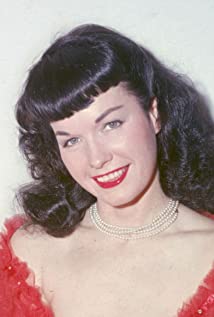Bettie Page
Bettie Page's life was filled with cult myth, mystery and sadness. Her image captured the imagination of a generation with her free spirit and unabashed sensuality, during an era of strong sexual repression. She was the quintessential pin-up, tacked up on walls in military barracks and garages; five decades later, some feminists still hail her as a pioneer of women's liberation. It has been estimated that over 20,000 photographs of Bettie were taken, and new generations of fans still buy copies by the thousands. Born in Nashville, Tennessee to a part-Cherokee mother, she grew up in a family so poor "we were lucky to get an orange in our Christmas stockings." The family included three boys and three girls, and Page later said her father molested most of the girls. He eventually stole a police car for a cross-country trip, was caught and sent to prison, and for a time Bettie resided in an orphanage. Her parents divorced when she was 10 years old.
In her teens, Bettie acted in high school plays and was a straight-A student. She graduated from the Peabody College for Teachers in Nashville on a Daughters of the American Revolution scholarship in 1944, and went on to study drama in New York City. Her notorious career began one day in October 1950, while on a break from her job as a secretary in a New York office. On a walk along the beach at Coney Island, an amateur photographer admired the 27-year-old's curvaceous body and asked her to pose. Nudity didn't bother her, she said, likening it to Adam and Eve in the Garden of Eden. Her modeling career took off, and she was the centerfold in the January 1955 issue of then-fledgling Playboy magazine.
In 1951, Bettie fell under the influence of Irving Klaw, a photographer. He cut her hair into the dark bangs that became her trademark, and posed her in spiked heels and little else. She also appeared as a performer in over 50 burlesque films. Her photos and films were publicly denounced by civic and religious leaders as "perversion", and Klaw was later arrested for "conspiracy to distribute obscene material" through the United States mail. Bettie was called to testify in a private session. Senator Estes Kefauver of Tennessee, her home state, even launched a congressional investigation against her. Believing that her days as a pin-up were over, Bettie retreated from public view, later saying she was hounded by federal agents. Her early marriage to her high school sweetheart had ended in divorce; she moved to Florida in 1957 and married a much younger man, but that marriage also failed, as did a third, and she suffered a nervous breakdown.
In 1959, she was lying on a sea wall in Key West when she saw a church with a white neon cross on top. She walked inside and became a born-again Christian. After attending Bible school, she wanted to serve as a missionary but was turned down. Instead, she worked full-time for evangelist Billy Graham's ministry. However, a move to Southern California in 1979 brought her more troubles. She was arrested after an altercation with her landlady. Doctors diagnosed her as suffering from acute schizophrenia, and she spent 20 months in Patton State Hospital in San Bernardino and she was subsequently placed under state supervision for eight years.
Her mysterious disappearance from the public eye only fueled the public's fascination. In fact, for two decades no one was sure where she was or even if she was still alive. She resurfaced in the 1990s after being tracked down for a documentary. She occasionally granted interviews and sold autographs, but refused to allow her picture to be taken in her old age. In a 1993 telephone interview, she told a reporter that she was "penniless and infamous." She later hired a law firm to help her recoup some of the profits being made with her likeness. She spent her final years residing in Los Angeles with her brother.
After a three-week battle with pneumonia, Bettie Page suffered a deadly heart attack at age 85 on December 11, 2008.

